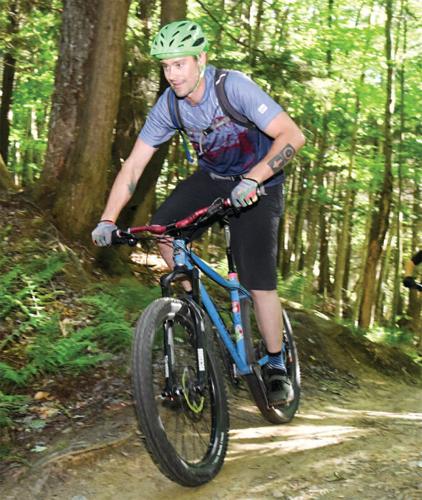It’s becoming one of Stowe’s favorite love songs: the swish of tires on dirt against the soft, lubricated percussion of spokes through otherwise quiet woods, punctuated only by the occasional whoop of glee.
Mountain biking is fast becoming Stowe’s summer crush. It’s easy to get into and public groups abound. Its allure is similar to a freshly powdered hill on a bright winter morning, so it’s no surprise that it attracts the same crowds.
You can see them gathering at the trailhead after a hard ride, leaning on hatchbacks and bike racks to wipe their brows and compare notes on what master trail-builder Hardy Avery calls the “brown pow.”
“We’re always chasing the elusive brown pow,” Avery said. “It’s like how you want to be on the part of the mountain with the fresh powdered snow, where no one is. You want a nice, soft, lonely surface. That’s beautiful.”
Avery is the composer behind the ballad of the mountain bikes here in Stowe. He’s been in business for himself under the moniker Sustainable Trailworks for the past nine years, although when pressed, he can’t quite put a finger on when he started crafting woodland trails. He’s been doing it for long enough that his stamp is on trails that wind through Cady Hill in Stowe, including its signature steep-grade climb, and on some of the Trapp Family Lodge biking trails and even a project or two at Norwich University.
When talk turns to the hows, whys and whens of trail-making, Avery’s voice warms up.
“I’m probably going to tell you way more than you need to know,” he said.
Before Avery puts down his first marker flag or even opens a map, he walks in its entirety the land he’s about to divide. That can take one day or up to four, he says.
“You scout the property,” Avery said. “It’s just walking. No flags, no property lines. You’re determining what its assets are.”
When he’s scouting, Avery takes into consideration both the land’s trouble spots — potential water drainage issues, inclines — and the parts he’s excited to include. “I go through with a detailed eye and pick out the terrain features. Like, for instance, the 500-year-old pine tree that you really want people to see.”
Once he’s acquainted with the land, Avery works up a conceptual design, which includes a map. From there, it’s a matter of getting the map approved by whomever he’s building for and determining the cost.
Then, the fun begins.
Avery loves building trails that celebrate the natural landscape. “I like interesting rock formations you can ride on, or open, exposed ledges,” he said. “My trails really focus on aesthetics. It’s important. It’s like I’m creating my own art out there, putting my imprint on the land.”
Avery says his favorite part of building a trail is exposing the terrain. “I love being able to bring people to places they’ve never been. It gives people the opportunity to be on the land.”
When he’s building a trail, Avery can take one of two approaches: He can set to work by hand or with a machine. He specializes in both machine-built and hand-built trails. The 1,200-foot Cady Hill Climb was constructed by Avery and his machine.
“Machines are faster and cheaper. They make a wider tread, so it’s more durable for much less money,” Avery said. “They’re also easier to maintain. It’s more efficient overall.”
Avery says with his machine he can average 300 to 400 feet of trail built every day. By hand, his rate is half that.
Machine-built trails are best for places like Cady Hill that get a lot of traffic, says Evan Chismark, executive director of the Stowe Mountain Bike Club. Excessive traffic is one factor in trail breakdown, so trails that carry a lot of riders need to be built to accommodate the load.
“Here, we build to a standard of 100 people a day,” Avery said.
Despite the efficiency of the machine, Avery says trails lose something when they’re made with a machine. Hand-built trails have their place, he says.
Right now, Avery is gearing up to design and build Callagy’s Trail in Sterling Forest in honor of Callagy Ross, a 23-year-old Stowe woman who died in a snowboarding accident last year.
That trail will be built by hand, Avery said, so it’s more in keeping with the Sterling Forest area, which is less accessible than the machine-built Cady Hill trails.
That’s the key difference between the two methods, according to Avery. Building a trail by hand allows for a “more primitive feel.”
“It’s a little more soulful,” Avery said. Hand-built trails tend to be single paths, meaning riders can’t ride two-abreast. Riders seeking more challenging routes often prefer hand-built trails.
But Avery doesn’t go it alone. Volunteers are crucial to the building of trails, especially the ones built by hand. Chismark says last year, the Stowe Mountain Bike Club clocked 800 hours of volunteer work. Volunteers can help do anything from picking up brush to digging, all under the direction of the trail-builder.
“There’s something really remarkable about looking at raw woods and then later seeing a trail there. It’s like, ‘We built this, and now we can ride our bikes on it!’” Chismark said. “It’s the kind of thing you can really take pride in. It’s a rewarding, fulfilling job.
“Let’s not overcomplicate this, though. It’s wicked fun.”
























(0) comments
Welcome to the discussion.
Log In
Keep it clean. Please avoid obscene, vulgar, lewd, racist or sexual language.
PLEASE TURN OFF YOUR CAPS LOCK.
Don't threaten. Threats of harming another person will not be tolerated.
Be truthful. Don't knowingly lie about anyone or anything.
Be nice. No racism, sexism or any sort of -ism that is degrading to another person.
Be proactive. Use the "Report" link on each comment to let us know of abusive posts.
Share with us. We'd love to hear eyewitness accounts, the history behind an article.